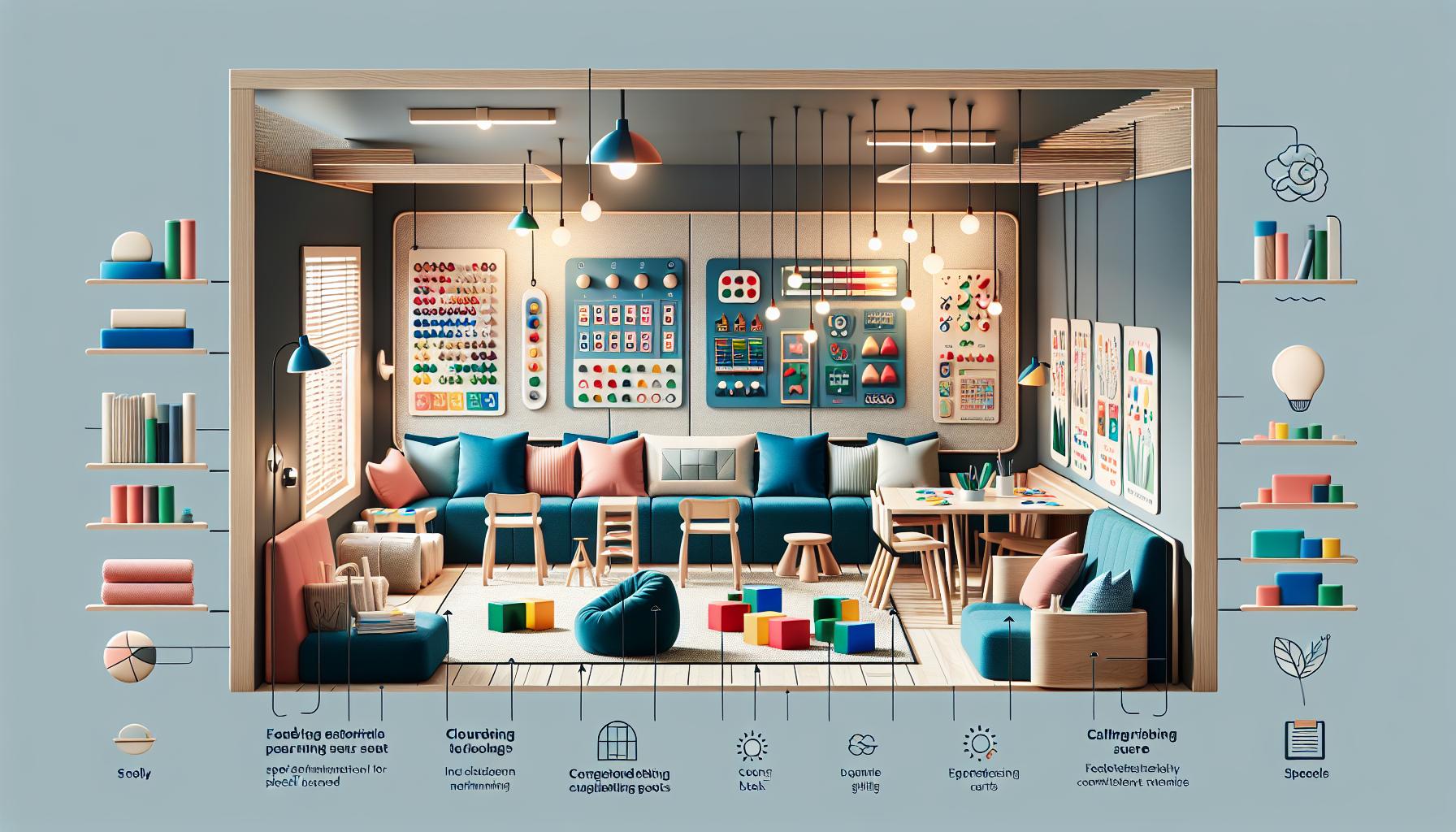
Choosing to homeschool a child with special needs can feel overwhelming at first. We understand the mix of emotions parents experience when considering this educational path. From questions about curriculum to concerns about socialization, there’s a lot to think about.
We’ve helped countless families discover that homeschooling can offer a flexible learning environment perfectly suited to children with special needs. By creating a personalized education plan, we can focus on your child’s strengths while supporting their challenges. After all, who knows your child better than you?
Teaching a special needs child at home lets us move at the right pace and adapt methods as needed. Would you like to learn how to build a learning space where your child can truly thrive? Let’s explore how homeschooling can transform your family’s educational journey.
Key Takeaways
- Homeschooling provides a flexible, personalized learning environment that can be perfectly adapted for children with special needs, allowing them to learn at their own pace.
- Creating a sensory-friendly learning space with proper lighting, noise reduction, and organized tools is crucial for supporting special needs students’ focus and engagement.
- A customized curriculum, developed through careful assessment and goal-setting, helps address individual learning challenges while maintaining academic progress.
- Building strong support systems, including professional therapists and connections with other homeschool families, is essential for successful special needs homeschooling.
- Regular documentation and progress tracking through learning logs, portfolios, and assessments helps monitor development and celebrate achievements effectively.
- Understanding state regulations and available resources, including funding options and educational support services, ensures compliance and maximizes learning opportunities.
Understanding Special Needs Education at Home
Special needs education at home creates opportunities for personalized learning experiences that adapt to each child’s specific requirements. Parents can implement targeted strategies while maintaining a supportive atmosphere that promotes growth and development.
Common Learning Challenges
Students with special needs often face distinct educational hurdles such as:
- Processing delays in reading comprehension or math calculations
- Difficulty with attention span during learning activities
- Sensory sensitivities to light, sound or touch
- Motor skill challenges affecting writing or physical tasks
- Communication barriers in expressing thoughts or needs
- Executive function issues with organization or time management
Each challenge requires specific accommodations that traditional classrooms might not provide. A structured home learning environment allows for immediate adjustments to support these learning differences.
Benefits of the Home Environment
The home setting offers several advantages for special needs education:
- Flexible Scheduling
- Arrange lessons during peak attention periods
- Include necessary therapy sessions within the daily routine
- Take breaks based on individual stamina levels
- Customized Learning Space
- Reduce sensory distractions with proper lighting
- Create quiet zones for focused work
- Set up adaptive equipment where needed
- Individualized Pacing
- Spend extra time on challenging concepts
- Move quickly through mastered material
- Adjust daily workload based on energy levels
- Immediate Support
- Address questions as they arise
- Provide instant feedback on assignments
- Modify teaching methods in real-time
- Fixed schedules that don’t match energy levels
- Classroom noise that affects concentration
- Limited one-on-one instruction time
- Pressure to keep pace with peers
Creating an Effective Learning Space

A dedicated learning environment supports special needs students’ focus and engagement. The right setup minimizes distractions and maximizes educational opportunities through thoughtful organization and appropriate tools.
Sensory-Friendly Setup
A sensory-friendly learning space starts with proper lighting control. Installing dimmer switches or using natural light filters helps students who experience light sensitivity. Here are key elements for a calming environment:
- Install soft, diffused lighting fixtures to reduce glare
- Add noise-reducing materials like carpet tiles or acoustic panels
- Create designated quiet zones with comfortable seating options
- Use neutral colors on walls to minimize visual stimulation
- Position desks away from high-traffic areas to limit movement distractions
- Multi-sensory manipulatives (counting blocks, letter tiles, texture cards)
- Visual schedules with removable picture cards
- Adaptive seating options (therapy balls, wobble cushions, standing desks)
- Technology aids (text-to-speech software, touch screens, specialized keyboards)
- Organization systems (color-coded folders, labeled storage bins, daily planners)
| Tool Type | Purpose | Examples |
|---|---|---|
| Sensory Tools | Physical comfort | Weighted lap pads, fidget items |
| Visual Aids | Learning support | Charts, timers, picture cards |
| Adaptive Equipment | Accessibility | Pencil grips, slant boards |
| Tech Devices | Digital learning | Tablets, learning apps |
Developing a Customized Curriculum

A customized curriculum forms the foundation of successful homeschooling for special needs students. This personalized approach addresses specific learning requirements while maintaining academic progress.
Assessment and Goal Setting
The first step in developing a curriculum starts with a comprehensive assessment of the student’s current abilities. Academic testing identifies strengths in subjects like math or reading while evaluating areas that need additional support. Regular progress monitoring through:
- Daily observation notes tracking learning patterns
- Weekly skill assessments measuring concept mastery
- Monthly reviews comparing goals against achievements
- Quarterly evaluations adjusting educational strategies
Setting SMART goals helps create achievable learning objectives:
- Specific targets for each subject area
- Measurable benchmarks to track progress
- Attainable milestones based on individual capacity
- Relevant skills aligned with student interests
- Time-bound goals with flexible deadlines
Adapting Teaching Methods
Different learning styles require varied teaching approaches matched to the student’s needs. Common adaptations include:
Multi-sensory learning techniques:
- Visual aids like charts graphs diagrams
- Hands-on activities with manipulatives
- Audio recordings for auditory learners
- Movement-based learning exercises
Pacing modifications:
- Breaking lessons into smaller segments
- Extended time for processing information
- Frequent breaks to maintain focus
- Repeating concepts using different methods
- Text-to-speech software for reading support
- Speech recognition for writing assistance
- Educational apps targeting specific skills
- Adaptive learning programs tracking progress
| Learning Style | Teaching Method | Example Activities |
|---|---|---|
| Visual | Graphic Organizers | Mind maps color coding |
| Auditory | Verbal Instruction | Songs rhymes discussions |
| Kinesthetic | Hands-on Learning | Building models experiments |
| Mixed | Combined Approach | Interactive digital lessons |
Building Support Systems
A strong support network empowers special needs homeschooling families with professional guidance and community connections. Creating these support systems helps sustain successful homeschooling efforts through shared experiences and expert insights.
Working With Therapists
Professional therapists form a critical part of a special needs homeschooling team. Speech therapists, occupational therapists, physical therapists or behavioral specialists provide targeted interventions that complement home education. Here’s how to integrate therapy services effectively:
- Schedule therapy sessions during optimal learning times
- Request specific exercises to incorporate into daily lessons
- Document progress using therapist-recommended tracking methods
- Share curriculum plans to align therapeutic goals with academic objectives
- Implement therapy techniques across different subjects
Regular communication with therapists enables:
- Quick adjustments to learning strategies
- Early identification of emerging challenges
- Celebration of developmental milestones
- Integration of therapeutic tools into lessons
Connecting With Other Homeschool Families
Building relationships with other homeschool families creates valuable support networks. Local homeschool groups offer opportunities for:
- Organized field trips with accommodating families
- Resource sharing of specialized materials
- Weekly social activities in supportive settings
- Parent support meetings to exchange ideas
- Cooperative learning sessions for specific subjects
Online communities extend support through:
- Virtual meetups with families facing similar challenges
- Discussion forums for curriculum recommendations
- Social media groups focused on special education
- Online co-learning opportunities
- Resource exchanges via digital platforms
Consider joining:
- Special needs homeschool cooperatives
- Inclusive recreational programs
- Parent mentor partnerships
- Skills-based learning groups
- Virtual study sessions
These connections provide emotional support, practical advice and opportunities for children to develop social skills in understanding environments.
Legal Requirements and Rights
Homeschooling special needs children involves specific legal considerations that protect educational rights while maintaining academic standards. Here’s what families need to know about the legal framework and available support.
State Regulations
Each state maintains distinct homeschooling regulations for special needs students. Parents must submit documentation including:
- Individual Education Plans (IEPs) or equivalent home education plans
- Progress reports at designated intervals (quarterly in most states)
- Annual assessments or evaluations of student achievement
- Proof of instruction in core subjects like math, reading, and science
The number of required instructional hours varies by state, ranging from 180 days to 990 hours per academic year. Local education agencies often require regular communication about:
- Learning objectives and curriculum choices
- Implemented accommodations and modifications
- Student progress and assessment results
- Changes to educational strategies or support services
Available Resources and Funding
Special needs homeschool families can access various funding sources and educational resources:
Federal Programs:
| Program Type | Available Support |
|---|---|
| IDEA Funding | $1,000-3,000 annually for therapy services |
| Tax Credits | Up to $2,000 per child for educational expenses |
| Grants | $500-5,000 for adaptive technology |
- Education Savings Accounts (ESAs) for curriculum materials
- Therapy service vouchers
- Access to public school resources
- Special education consultations
- Adaptive equipment lending programs
Parents can combine multiple funding sources to create comprehensive support packages. Local disability organizations often provide:
- Free educational assessments
- Resource libraries
- Training workshops
- Technology assistance
- Curriculum adaptation support
Contact your state’s Department of Education or local homeschool association for specific eligibility requirements and application procedures.
Managing Daily Routines
Daily routines create stability for special needs students in a homeschool environment. Structured schedules combined with flexibility help students thrive while meeting their educational goals.
Scheduling Strategies
Effective scheduling starts with identifying peak learning times for academic subjects. A visual schedule board displays daily activities using pictures or written cards, making transitions smoother. Here’s what works:
- Block scheduling in 20-30 minute segments for focused learning
- Regular movement breaks between subjects to maintain attention
- Visual timers to help students track activity duration
- Morning routines that prepare students for learning
- Afternoon slots for hands-on activities when energy levels drop
| Time Block | Activity Type | Duration |
|---|---|---|
| Morning | Core Subjects | 2-3 hours |
| Mid-day | Movement/Art | 1-2 hours |
| Afternoon | Light Learning | 1-2 hours |
Balancing Therapy and Academics
Integrating therapy sessions into the academic schedule maximizes learning potential. Speech language exercises blend naturally with reading lessons while occupational therapy activities complement handwriting practice.
Key integration points include:
- Scheduling therapy sessions during optimal energy levels
- Incorporating therapy exercises into academic lessons
- Recording therapy goals in the daily schedule
- Planning recovery time after intensive sessions
- Using therapy tools during academic work
| Therapy Type | Integration Method | Academic Connection |
|---|---|---|
| Speech | Word Games | Reading/Language |
| OT | Fine Motor Tasks | Writing/Math |
| PT | Movement Breaks | PE/Science |
- Student’s energy levels
- Therapy appointment schedules
- Learning progress
- Medical appointments
- Seasonal changes
Tracking Progress and Growth
Special needs homeschooling requires consistent tracking to capture academic milestones. Regular assessment helps parents identify effective teaching methods while documenting their child’s development.
Documentation Methods
Effective documentation starts with daily learning logs that record completed activities, skills practiced, and behavioral observations. A digital portfolio showcases student work through photos, videos, and scanned assignments. Parents benefit from using:
- Assessment checklists for tracking skill mastery
- Progress journals noting behavioral patterns and academic growth
- Learning management systems to organize grades and assignments
- Regular video recordings of reading fluency and physical activities
- Weekly skill inventories measuring advancement in specific areas
Here’s a sample tracking framework:
| Time Period | Documentation Type | Key Elements to Record |
|---|---|---|
| Daily | Learning Log | Activities, duration, mood |
| Weekly | Skill Review | Mastered concepts, challenges |
| Monthly | Portfolio Update | Work samples, photos, videos |
| Quarterly | Progress Report | Goal achievement, adjustments |
Celebrating Achievements
Recognition of progress boosts confidence and motivation in special needs students. Small wins deserve acknowledgment through:
- Digital badges for completing assignments
- Milestone charts displaying new skills learned
- Photo albums capturing learning breakthroughs
- Special activity rewards tied to goal completion
- Achievement certificates for mastering concepts
Creating celebration rituals helps students visualize their growth:
- Display completed work in a dedicated space
- Share accomplishments during family meetings
- Mark progress on visual growth charts
- Take milestone photos with completed projects
- Record video messages highlighting achievements
| Achievement Type | Celebration Method | Frequency |
|---|---|---|
| Daily Goals | Sticker charts | End of day |
| Weekly Targets | Choice activities | Friday |
| Monthly Progress | Special outings | Last week |
| Major Milestones | Family celebration | Upon completion |
Conclusion
Taking the homeschooling journey with a special needs child opens up incredible possibilities for personalized education and growth. We’ve seen how dedicated learning spaces home-based scheduling and individualized support can transform educational experiences for children with unique requirements.
Our commitment to understanding and meeting these needs through customized curricula therapy integration and strong support systems creates a foundation for success. We believe every child deserves an education that celebrates their strengths and supports their challenges.
Starting your homeschooling journey might feel overwhelming but remember you’re not alone. With proper planning documentation and a supportive community we can create enriching educational experiences that help our special needs children thrive and reach their full potential.
Frequently Asked Questions
What are the main benefits of homeschooling a child with special needs?
Homeschooling offers a flexible learning environment tailored to your child’s individual needs. It allows for personalized pacing, immediate feedback, customized learning spaces, and reduced sensory distractions. Parents can adjust teaching methods instantly and provide one-on-one attention that may not be available in traditional classrooms.
How do I create an effective learning space for my special needs child?
Set up a dedicated area with minimal distractions, proper lighting control, and noise-reducing materials. Include designated quiet zones, neutral colors, and appropriate seating options. Add multi-sensory tools, visual schedules, and necessary technology aids to support learning and accessibility.
What legal requirements should I consider when homeschooling a special needs child?
Requirements vary by state but typically include submitting documentation like Individual Education Plans (IEPs), progress reports, and proof of core subject instruction. Check your state’s specific regulations and maintain proper records of your child’s educational progress and achievements.
How can I integrate therapy services into homeschooling?
Coordinate with therapists (speech, occupational, physical) to incorporate therapy exercises into daily lessons. Maintain regular communication to adjust learning strategies and track progress. Schedule therapy sessions during optimal learning times and blend therapeutic activities with academic content.
What support systems are available for special needs homeschooling families?
Connect with local homeschool groups, online communities, and special needs cooperatives for resource sharing and emotional support. Seek professional guidance from therapists and educators. Join virtual meetups and discussion forums to network with other families facing similar challenges.
How do I track my child’s progress in homeschooling?
Use daily learning logs, digital portfolios, assessment checklists, and progress journals to document achievements. Create milestone charts and implement regular evaluations to monitor growth. Celebrate accomplishments through digital badges, charts, and family celebrations to maintain motivation.
Can I receive financial assistance for homeschooling a special needs child?
Yes, various funding options are available, including federal programs, tax credits, grants, and education savings accounts. Research state-specific resources and programs designed to support special needs education at home. Contact local education authorities for information about available assistance.
How do I develop a customized curriculum for my special needs child?
Conduct comprehensive assessments to identify strengths and areas needing support. Set SMART goals and adapt teaching methods to match your child’s learning style. Include multi-sensory techniques, appropriate pacing modifications, and supportive technology to enhance learning effectiveness.

